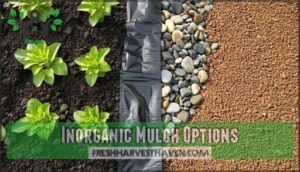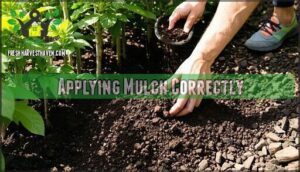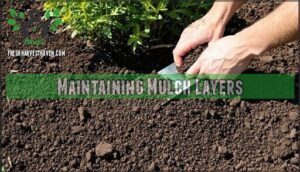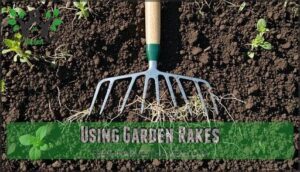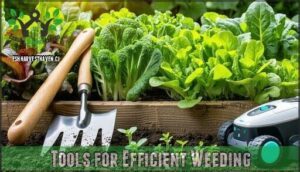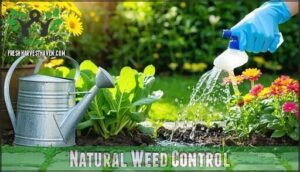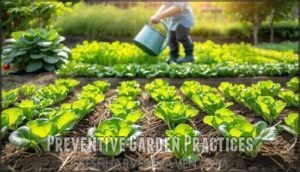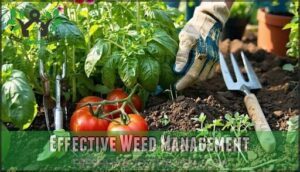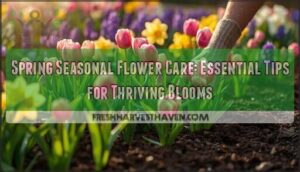This site is supported by our readers. We may earn a commission, at no cost to you, if you purchase through links.
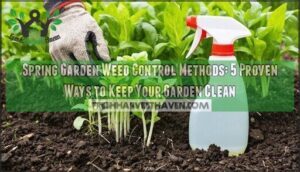
Start with mulching—it’s your secret weapon that smothers weeds before they even think about sprouting.
Pull stubborn weeds by hand when soil’s damp (they’ll slide out like butter), then spray natural vinegar solutions on the survivors.
Plant densely to crowd out competition, and time your attacks when weeds are young and vulnerable.
These spring garden weed control methods create layers of defense that’ll keep your beds pristine without harsh chemicals.
The real magic happens when you combine these techniques strategically throughout the season to achieve a pristine garden.
Table Of Contents
- Key Takeaways
- Mulching Techniques
- Manual Weed Removal
- Natural Weed Control
- Preventive Garden Practices
- Effective Weed Management
- Frequently Asked Questions (FAQs)
- What weed control to use in spring?
- What is the best thing to kill weeds but not grass?
- What is the best defense against weeds in your vegetable garden?
- What time of year should I start weeding?
- How often should I weed my garden?
- Which weeds are hardest to control naturally?
- Can I prevent weeds without using chemicals?
- Whats the best weather for weed removal?
- Conclusion
Key Takeaways
- Start with mulching as your foundation – Apply 2-4 inches of organic mulch around plants to block sunlight and prevent weed seeds from germinating, creating an impenetrable barrier that also retains moisture and enriches soil.
- Pull weeds when the soil is moist for easy removal – Target young weeds after rainfall when roots slide out effortlessly, preventing regrowth by getting the complete root system before they establish deep networks.
- Combine natural methods for maximum impact – Use vinegar solutions on survivors after hand-pulling, apply boiling water for stubborn patches, and create dense plantings that crowd out competition through natural suppression.
- Time your attacks strategically throughout spring – Begin weeding when the soil is workable (2-4 weeks before the last frost), maintain weekly removal during peak season, and apply pre-emergent treatments when the soil hits 50-55°F.
Mulching Techniques
You’ll find mulching is your garden’s best friend for blocking weeds before they even start growing.
Think of it as laying down a protective blanket that keeps those pesky invaders in the dark while keeping your soil happy and moist.
Organic Mulch Benefits
Organic mulch works like nature’s own blanket, delivering five key benefits that’ll make your garden thrive.
You’ll get superior weed suppression as decomposing materials like shredded leaves and wood chips block sunlight from reaching pesky weed seeds.
Plus, organic mulch excels at moisture retention, keeping your soil consistently hydrated while enriching it with nutrients.
Consider different types available for your specific gardening needs.
This natural soil enrichment process improves structure and supports healthy plant growth through temperature regulation and erosion control.
Inorganic Mulch Options
When organic mulch isn’t your style, inorganic options pack a punch.
Plastic mulch creates an impenetrable weed barrier while warming soil for heat-loving crops. Landscaping fabric lets water through but blocks weeds cold.
Gravel mulch adds permanent appeal to paths, while rubber mulch won’t blow away in storms. These synthetic heroes don’t decompose, so they’ll keep fighting weeds season after season.
Alternatively, consider soil solarization techniques for effective weed control using synthetic heroes that provide an impenetrable solution.
Applying Mulch Correctly
Getting your mulch depth just right makes all the difference in weed control.
Apply organic mulch in layers one to four inches thick, keeping it a few inches away from plant stems to prevent rot.
For slopes, use heavier materials like wood chips to prevent erosion.
Many gardeners find benefits of using mulch for weed control.
Proper material selection and plant spacing guarantee your mulching efforts pay off with excellent soil moisture retention.
Maintaining Mulch Layers
Once you’ve applied mulch correctly, keeping it fresh is like maintaining a good friendship – it needs regular attention.
Your organic mulch breaks down over time, so you’ll need to refresh it annually to maintain that vital 2-4 inch mulch depth.
Check your mulch material regularly for decomposition signs.
When it’s looking thin or patchy, add fresh layers to restore its moisture retention powers and weed-blocking abilities.
To facilitate accurate measurement, consider using a mulch depth tool.
Manual Weed Removal
Sometimes the best approach is going back to basics with your hands and simple tools.
Manual weed removal gives you complete control and works great when you catch weeds early, plus there’s something oddly satisfying about yanking those pesky invaders right out of your garden beds, which can be a satisfying experience.
Hand-Pulling Weeds
Pull weeds by hand when soil’s moist – it’s like nature’s giving you a helping hand.
Twist gently at the base to grab those sneaky roots, preventing regrowth.
For stubborn weeds, use a fork for tool assistance and proper technique.
- Root removal becomes effortless in wet conditions
- Soil moisture makes manual weeding feel like a breeze
- Handpulling gives you total control over your garden’s fate
- Manual weed removal connects you directly with your plants
Using Garden Rakes
Your garden rake becomes your secret weapon for tackling larger weedy areas efficiently.
Choose a sturdy rake with sharp tines, then drag it through soil to uproot shallow-rooted weeds before they establish themselves.
The key is using quick, firm strokes that disturb the soil surface while preserving your desirable plants nearby.
Consider using a rake with ergonomic garden shears to reduce hand strain and make the process more efficient with minimal effort.
Hoeing Young Weeds
Sharp-blade satisfaction beats dull disappointment every time.
You’ll want to hoe when weeds are tiny seedlings, making quick work of spring weed control.
Choose your blade based on soil type—stirrup hoes work great in loose dirt, while draw hoes tackle tougher ground.
Proper ergonomic hoeing means keeping that tool upright to save your back.
Regular hoeing frequency prevents soil disturbance from becoming a major headache later.
Tools for Efficient Weeding
When hand-pulling and hoeing aren’t enough, the right weed control tools make all the difference.
Smart gardeners know that having specialized equipment saves time, energy, and your back.
- Ergonomic Weeders – Long-handled tools reduce bending and strain
- Specialized Hoes – Stirrup and oscillating hoes slice through weeds efficiently
- Powered Weeders – Electric cultivators tackle stubborn root systems
- Weeding Robots – Automated solutions for tech-savvy gardeners
Natural Weed Control
You don’t have to rely on harsh chemicals to win the war against weeds – nature’s got your back with some surprisingly effective solutions.
From kitchen staples like vinegar to simple boiling water, these natural methods can zap those pesky invaders while keeping your garden safe for kids, pets, and beneficial insects.
Compost as Weed Suppressant
Your best friend for natural weed control isn’t some fancy product—it’s compost.
This organic matter creates a powerful barrier that blocks sunlight while enriching your soil.
Apply a two-inch layer around plants for maximum weed suppression.
Quality compost prevents seed germination, boosts soil health, and costs way less than chemical alternatives.
It’s like giving your garden a nutritious breakfast that keeps weeds hangry.
Mulching also deprives weeds of sunlight, and shredded leaves work well for this.
Vinegar as Herbicide
White vinegar packs a punch as nature’s weed-whacking warrior, but don’t expect miracles from your kitchen cabinet.
You’ll need 20% acetic acid concentration for stubborn perennials, while 5-10% handles young weeds just fine.
These natural herbicides work best on sunny days, targeting broadleaf troublemakers more effectively than grassy invaders.
Remember, vinegar’s a contact killer – it won’t touch those sneaky roots, so expect some comebacks.
For ideal results, apply it to weed leaves directly.
Boiling Water for Weed Control
Boiling water delivers instant results when you need to eliminate stubborn weeds fast. This natural weed control method kills weeds by destroying their cell structure, causing them to wilt within hours.
Hot water hits weeds like nature’s instant delete button—fast, effective, and absolutely final.
You’ll want to pour carefully to avoid harming nearby plants, as scalding water doesn’t discriminate between weeds and flowers.
- Boiling water safety: Wear protective gear and pour slowly to prevent splashing on yourself or desired plants
- Scalding weed effectiveness: Works best on young, tender weeds rather than established perennials with deep root systems
- Plant collateral damage: Create barriers around valuable plants using cardboard or plastic sheeting before application
- Soil temperature impact: Hot water temporarily raises soil temperature but won’t cause long-term damage to beneficial microorganisms
Essential Oils for Weed Killing
Beyond vinegar, essential oils pack a punch as natural weed killers. Clove, cinnamon, and wintergreen oils disrupt weed cell membranes when mixed with water and soap.
You’ll need proper oil dilution—3-5 drops per 16 oz spray bottle—for effective application methods. These organic weed control solutions work best on young weeds during hot, dry conditions, though plant sensitivity varies by species.
A DIY recipe often includes vinegar and dish soap.
| Essential Oil | Best Target Weeds |
|---|---|
| Clove (eugenol) | Broadleaf weeds, dandelions |
| Cinnamon | Germinating seeds, young shoots |
| Wintergreen | Grass weeds, barnyard grass |
Oil combinations can boost effectiveness, but some mixtures reduce potency. Always follow safety precautions—these natural weed control methods still require careful handling around desirable plants.
Preventive Garden Practices
You can’t just react to weeds after they’ve taken over your garden – smart gardeners know that prevention beats cure every time.
By setting up the right conditions from the start, you’ll create a garden where your plants thrive while weeds struggle to get a foothold, which is the key to a successful and thriving garden.
Crop Rotation Benefits
Crop rotation isn’t just swapping plants around—it’s your secret weapon for weed control and garden planning.
When you rotate crops, you’re disrupting weed cycles that have adapted to specific plants.
This simple sustainable gardening practice improves soil health, maintains nutrient balance, and reduces pest disruption.
Different crops pull different nutrients, so rotating them naturally starves weeds while boosting your yield increase.
Dense Plantings for Weed Suppression
How can you squeeze more plants into your garden while keeping weeds at bay?
Dense plantings create a natural weed suppression system through ideal spacing and companion plants.
When you select plants with complementary growth habits, their shading effects block sunlight from reaching weed seeds.
Smart plant selection means choosing varieties that spread naturally, creating thick canopies that outcompete unwanted invaders for nutrients and space, utilizing companion plants to achieve this goal.
Raised Beds for Reduced Weeds
Raised beds transform your spring weed control game by giving you complete command over your garden’s soil composition and drainage benefits.
You’ll discover that construction materials like cedar or composite boards create barriers that block wandering weeds from neighboring areas.
Here’s why raised beds crush weed problems:
- Accessibility advantages – Easy weeding without back strain means you’ll actually tackle those pesky invaders
- Pest reduction – Elevated growing space discourages ground-dwelling pests that spread weed seeds
- Superior mulch retention – Contained borders keep your weed prevention mulch exactly where it belongs
Your garden weed control efforts become laser-focused when you’re working within defined boundaries rather than battling weeds across sprawling ground-level plots.
Trimming Garden Edges
Clean garden edges don’t just look great—they’re your secret weapon for spring weed control.
Sharp edge definition blocks weed migration from lawns into beds.
Use a spade or edging tool monthly during growing season.
Plant dense border plants like boxwood to create natural barriers.
This simple step boosts aesthetic appeal while preventing invasive weeds from establishing footholds in your garden, making it a key part of weed control and improving overall aesthetic appeal.
Effective Weed Management
You’ve got your weed control methods down, but knowing when and how to use them together makes all the difference.
The secret isn’t just picking one technique—it’s creating a game plan that keeps weeds guessing while your garden thrives.
Weed Control Methods Comparison
Three main weed control strategies offer different strengths.
Mulching provides 90% method effectiveness with excellent long-term viability, while manual removal achieves 95% success for young weeds.
Natural methods like vinegar require repeated applications but deliver superior environmental impact.
Smart gardeners combine these nontoxic weed control approaches, creating powerful method synergies that outperform single-strategy solutions, utilizing complete concepts.
Timing for Weed Removal
Understanding when to tackle weeds makes all the difference in your spring garden weed control strategy.
You’ll want to strike during the ideal season when conditions favor easy removal and prevent future headaches. Consistent weeding in the fall prevents future growth, as early action prevents spread.
- Pre-emergent timing: Apply treatments before weed seeds germinate in early spring when soil temperatures reach 50-55°F
- Post-rain removal: Pull weeds within 24-48 hours after rainfall when soil is soft and roots come out easily
- Lifecycle stages: Target weeds during their seedling phase before they establish deep root systems and begin seed dispersal
Combining Methods for Best Results
You’ll get the best results by using multiple spring garden weed control methods together.
Try combining mulching with hand-pulling for a layered approach that delivers synergistic effects.
Start with dense plantings, then add organic mulch and spot-treat stubborn weeds with vinegar.
These integrated strategies work better than solo efforts, optimizing combinations for long-term control and nontoxic weed control success.
Maintaining a Healthy Garden Ecosystem
Building on effective weed control methods, you’ll want to nurture beneficial insects and natural predators that keep your garden thriving.
A healthy ecosystem naturally reduces weed pressure while supporting pollinator support and soil biodiversity.
Here’s how to maintain ecosystem balance:
- Add organic matter regularly – Compost feeds soil microbes that outcompete weeds
- Plant diverse flowers – Attracts beneficial insects that control pest populations
- Avoid harsh chemicals – Preserves natural predators and soil health
This ecofriendly gardening approach creates lasting weed prevention through nature’s own systems.
Frequently Asked Questions (FAQs)
What weed control to use in spring?
Like a gardener wielding a magic wand, you’ll want to combine multiple spring weed control methods for maximum effectiveness.
Start with hand-pulling young weeds when soil’s moist, apply thick organic mulch layers, and use natural vinegar solutions for spot treatments.
What is the best thing to kill weeds but not grass?
Selective herbicides target broadleaf weeds while sparing grass by exploiting biological differences.
They’re specifically formulated to kill dandelions, clover, and other lawn weeds without harming your turf, making them your best bet for precision weed control.
What is the best defense against weeds in your vegetable garden?
Your best defense against weeds is thick mulch applied 2-4 inches deep around plants.
This blocks sunlight, preventing weed seeds from germinating while retaining moisture and enriching soil as it decomposes, which is a complete concept for soil enrichment.
What time of year should I start weeding?
Here’s a 35-word answer about when to start weeding:
Early spring weeding reduces weed pressure by 80% throughout the growing season.
You’ll want to start weeding when soil’s workable, typically 2-4 weeks before your last frost date when weeds are young and vulnerable.
How often should I weed my garden?
You should weed your garden weekly during peak growing season, checking trouble spots every few days.
Young weeds are easier to pull, and consistent removal prevents them from setting seed and spreading throughout your garden beds, which makes weekly weeding a crucial task to prevent the spread of weeds, and consistent removal is key.
Which weeds are hardest to control naturally?
While folks think natural methods work on everything, persistent perennial weeds like dandelions, bindweed, and Canada thistle laugh at your vinegar spray.
They’ve got deep taproots and underground networks that bounce back stronger, which makes them particularly resistant to natural control methods.
Can I prevent weeds without using chemicals?
You’ve got tons of chemical-free options that work like a charm. Try thick mulch, hand-pulling when soil’s moist, dense plantings, cover crops, and natural sprays like vinegar.
Whats the best weather for weed removal?
Target wet soil conditions for easiest weed removal – moist earth lets you pull roots completely without breaking stems, preventing regrowth and saving you time.
Conclusion
Research shows that gardeners who use multiple weed control strategies reduce weed problems by 85% compared to single-method approaches.
You’ve got the tools now—these spring garden weed control methods work best when layered together like a defensive fortress.
Start with mulching as your foundation, pull weeds when they’re young, and spray survivors with vinegar solutions.
Dense plantings will crowd out future invaders while maintaining your garden’s natural balance, and remember, consistency beats perfection every time, so stick with these proven techniques and watch your garden thrive.
- https://www.farmstandapp.com/62088/7-best-organic-weed-control-solutions/
- https://edenscapeslh.com/weed-control-techniques/
- https://www.preen.com/learn/lawn-garden-tips/weed-control/get-rid-of-weeds/wondering-how-to-kill-weeds-for-good-think-prevention-instead/
- https://www.rhs.org.uk/prevention-protection/weeds-non-chemical-control
- https://ucanr.edu/blog/uc-weed-science/article/mechanical-weed-control-under-vine


